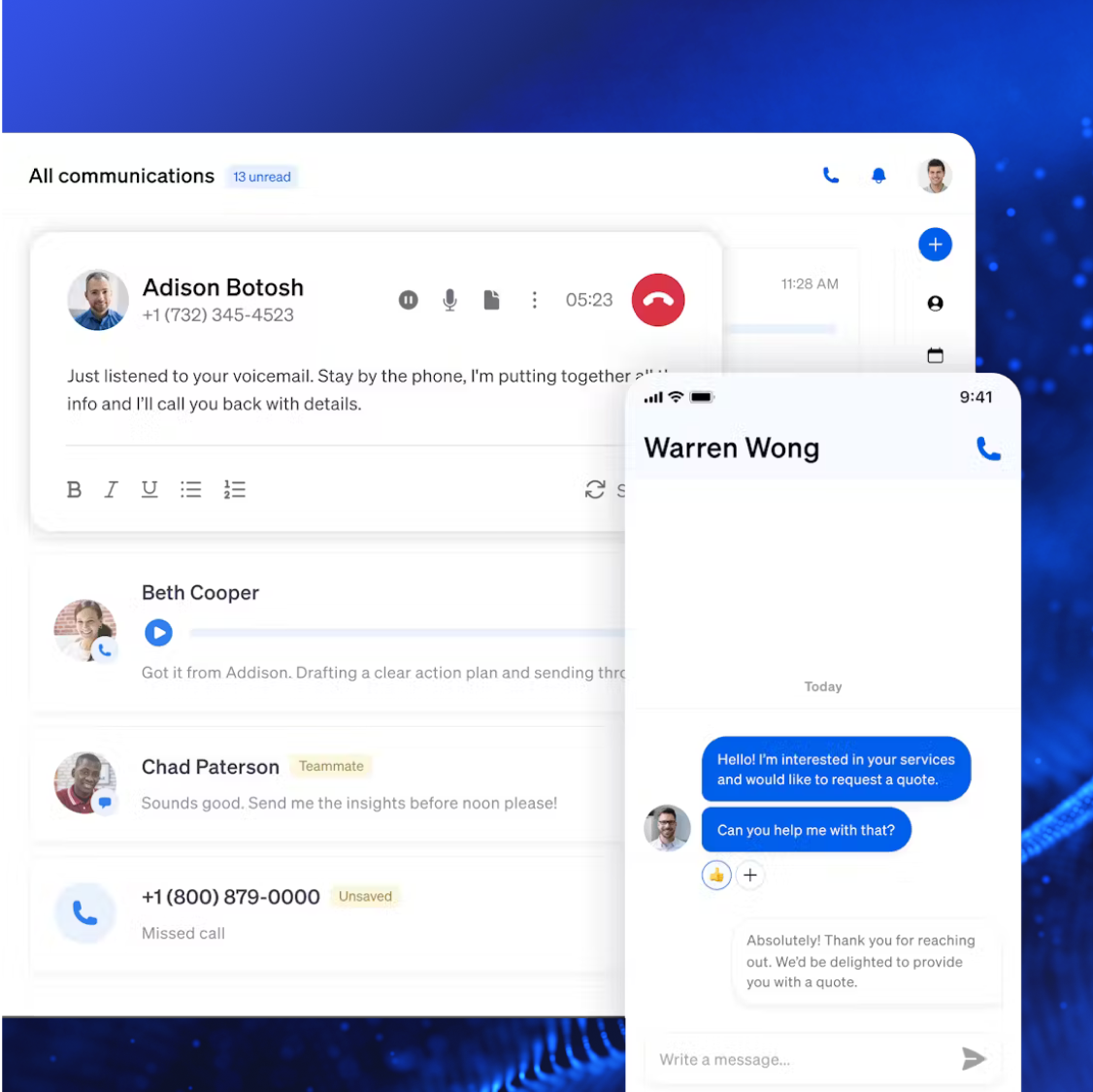Digital customer service means being there for your customers when they need you and on their digital channel of choice. According to our 2024 State of Customer Experience Report, 71% of customer service agents say switching between multiple communication channels makes it difficult to meet customer needs.
With customer expectations driving companies to innovate, adopting the right channels can help you streamline support and create exceptional experiences at all customer touchpoints across the digital journey.
To curb those expectations, businesses should offer a robust suite of digital customer service tools where users can connect with the right internal teams or find the right information. In this guide, we’ll break down the importance of digital customer service and give tips on implementing an effective digital strategy.
What Is Digital Customer Service?
Digital customer service refers to providing support and meeting customer needs via digital channels like social media, text, email, and live chat. It uses technology to enhance communication, personalize service, and address customer inquiries more conveniently than traditional customer service channels.
Types of digital customer service channels
Providing preferred channels reduces customer effort, improving their experience. Let’s look at the different types of digital channels you can add to your contact center.
- Live chat enables real-time interactions between customers and AI chatbots or human agents, instantly engaging with customers and offering personalized support.
- Social media allows businesses to engage with customers through posts, mentions, or DMs on platforms such as Threads, Facebook, Instagram, Bluesky, and TikTok.
- Email offers asynchronous communication, enabling customers to reach out at their convenience, making it ideal for detailed or complex inquiries.
- Self-service resources, like portals, knowledge bases, FAQs, and tutorials, enable customers to find answers independently and handle common tasks.
- Mobile apps provide on-the-go service with tailored experiences through tailored recommendations and timely push notifications to keep consumers updated.
- Messaging apps, like WhatsApp or Facebook Messenger, allow for quick, informal, one-on-one communication with multimedia support, making them perfect for casual inquiries and file sharing.
Video chat is common in IT and tech support, providing face-to-face interaction for complex issues. Features like screen sharing enable service reps to guide customers through processes with personalized support.
Why You Should Offer Digital Customer Care
Sometimes customers prefer traditional channels, like phone calls. But adding digital messaging channels to your omnichannel contact center allows customers the convenience of choosing how to get support and when they want it.
Here are a few benefits of digital service.

Improve agent productivity
Digital customer care means that automation can handle repetitive tasks, freeing up your customer service agents for challenging tasks that allow them to flex their problem-solving skills. The right solution can improve efficiency and productivity for all of your internal teams, helping them work together seamlessly to improve overall CX.
Make work easier for your team with conversational artificial intelligence (AI) tools like chatbots that can answer simple prompts. Self-service resources like FAQs and customer portals allow customers to skip the line and resolve issues on their own.
Some of the benefits of digital customer service include:
Offer personalized, customer-centric experiences
Generic customer service doesn’t make customer experiences memorable. According to Deloitte, the brands that offer the most personalized experiences exceed in customer loyalty metrics — at least 1.5x more effectively than those that don’t tailor their services.
CRM helps to personalize digital conversations and give the customer the perception that every interaction is authentic. With a digital customer service platform, you can effortlessly collect and analyze data on customer interactions. This makes it easier to provide personalized support and product improvements based on customer behavior and feedback.
In addition, CX analytics make it simpler to segment consumers by preference. When you segment customers, you can market to them more accurately with personalization, whether that’s a new product or an improvement to one they already use. This can even help improve your customer retention by introducing existing buyers to new product offerings.
Related: Customer Experience Analytics: How to Track and Improve CX
Provide faster, 24/7 customer service
Digital service helps speed up response times and increase the number of people your team can help. Your customers could be in any market or time zone (or keep odd hours), and they’ll expect support whenever they need it. Digital customer service platforms enable 24/7 customer support, a crucial component for meeting expectations, building trust, and growing satisfaction.
Thanks to tools like intelligent virtual agents, chatbots, and email support, digital customer care gives companies the resources they need to support a high volume of customers quickly, regardless of their location.

Deliver consistent brand messaging
With digital customer communications, your business can maintain a consistent brand presence no matter the channel. Here are a few features to help you deliver the right messaging during online digital customer experiences:
- Centralized knowledge bases provide all agents access to the same accurate information, ensuring consistent responses across email, live chat, and social media.
- Standardized scripts and templates help call center agents maintain your brand’s voice and tone, ensuring messaging aligns with your company’s identity.
- AI chatbots deliver consistent messaging throughout the digital customer journey.
- Real-time monitoring and feedback loops — such as customer satisfaction surveys (CSAT) — can identify inconsistencies and maintain quality control, ensuring a seamless brand experience.
This omnichannel consistency enhances brand recognition and builds customer trust.
Enhance workforce management
Digital tools enhance workforce management in contact centers by optimizing both agent and customer experiences. For customer service agents, it provides data-driven insights for more accurate forecasting, optimized scheduling, and real-time adjustments, ensuring the right staffing levels to meet demand.
Workforce management solutions also motivate agents and reduce burnout, leading to higher productivity and lower turnover. They streamline workflows, offer easy access to knowledge management platforms, and provide coaching tools that make day-to-day tasks easier, improving digital customer service quality.

Shift from a cost center to a profit center
Digital channels can be more cost-effective than traditional customer service channels like call centers. Digital call centers allow you to automate answers to common questions and limit the size of the service team you need to field inquiries.
Digital customer service can even help curb customer churn by flagging suspect accounts to managers for intervention. Those account managers can then use customer history to speak to specific issues that interest the customer and may influence them to stay on board.
Reimagine customer support as an investment to stay connected with customers and raise awareness of new and related products.

How to Implement a Digital Customer Service Strategy: 3 Action Items
It’s easier to keep up with and meet customer needs with the right strategy.

According to a survey from Webflow, 57% of responding marketing leaders agree that customers expect more than they did even 12 months ago. Additionally, a staggering 93% of respondents agree their team “must continually innovate to remain competitive” when it comes to improving the customer experience through a company’s digital offerings.
However, you might be overthinking how simple a comprehensive digital customer service experience can be.
Try these tips for a seamless digital customer experience strategy.
1. Don’t make your customers chase you
Businesses that offer customers a seamless omnichannel experience across phone calls, chats, emails, text messages, social media, and more may stand a better chance at delivering a positive CX.

In an interview with NPR, author, management consultant, and customer service expert Amas Tenumah calls out a poor cross-channel experience as a sign of a negative customer experience:
“[E]xpectations are rising. Commercials…promise you the world…and then objective reality hits. And you try to reach customer service. And you are met with a bot. You are met with wait times…that’s really where the chasm is. This gap between expectations and objective reality just continues to get and wider wider.”
~ Amas Tenumah, customer service expert and author
Meet your customers where they are. The best place to communicate with customers is where they prefer to reach you (or to be reached, depending on their preferences).
2. Get to the point with faster responses
Prioritize fast responses to customer inquiries for the best impact on customer experience. Businesses that respond quickly to customer requests are seen as more attentive, which lets customers know that their needs are on the way to being met if not met already.
There are plenty of ways to speed up agent response times to digital requests, including:
- Chatbots for automated responses to common questions
- Templated responses for quick and consistent agent answers
- Triage methods for prioritizing urgent messages
You can also use unified communication (UCaaS) solutions to make the most of your customer channels by integrating phone, live chat, and video chat into one platform. This way, agents can collaborate across teams so everyone has the information they need to tackle customer requests.
Self-service options, like FAQs, can take redundant questions away from agents so they have more time to solve complex problems that require human intervention. This can also help empower your team with the authority to make decisions that benefit the customer. And when employees feel trusted and responsible, they’re more likely to have high satisfaction and performance.
3. Take advantage of the data at your disposal
Customer data is a treasure trove of valuable information — don’t waste it. A digital customer service solution can help you track and make sense of customer habits, behaviors, conversations, and purchases to flesh out complete individual customer journey maps.

Most importantly, customer data helps businesses with the “why” of digital customer service. Data is key for personalizing services, strengthening customer relationships, and improving loyalty. Data is also crucial for any predictive analytics businesses might want to use to forecast the future, like during revenue planning.
Related: How to Build the Best Digital Customer Experience Strategy in 2024
Improve Your Digital Customer Service With Nextiva
When your customers are satisfied, you don’t have to spend as much to retain their business.
Consumers rely on more business communication channels than ever before, making digital customer service the newest battleground for capturing customer loyalty. To win this battle, you should use data to your advantage and provide channels that reduce customer effort.
With a comprehensive digital customer service platform like Nextiva, you can oversee smarter data collection and analysis. With customer insights from digital interactions, you can reach a wider audience, personalize more interactions, and swiftly resolve more customer queries.
The call center solution teams love.
Sales and support teams use Nextiva to deliver a better customer experience.















 Customer Experience
Customer Experience 









